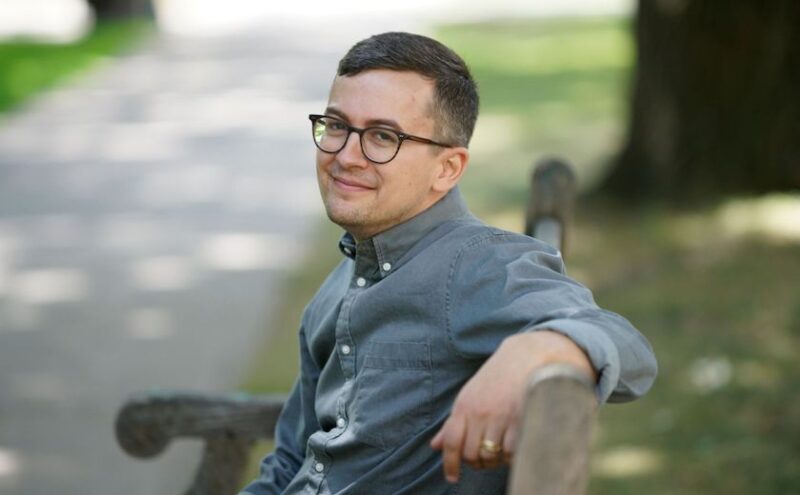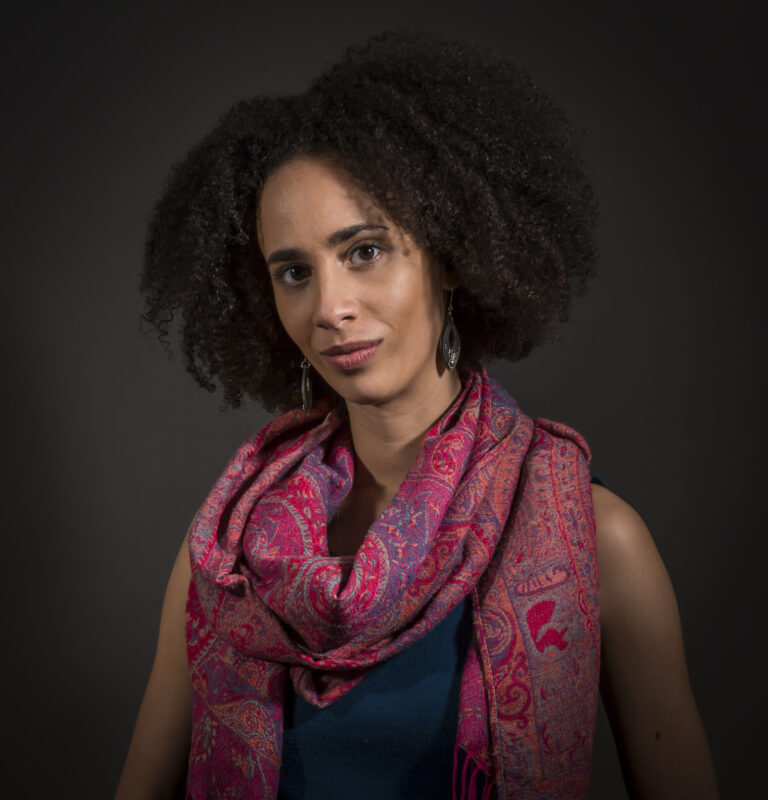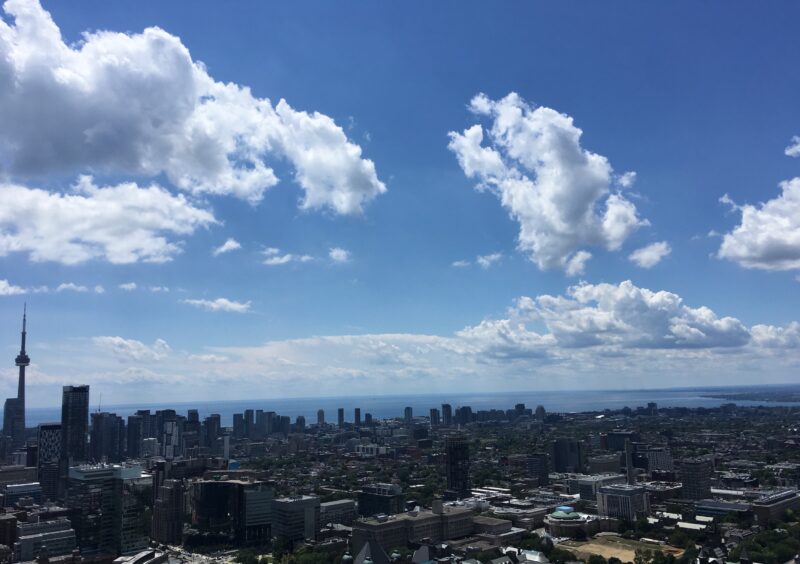When the Print Studio in the John M. Kelly Library re-opens later this month, it will offer students an opportunity to roll up their sleeves and get their hands dirty as they learn about moveable type and the process of printing.
The hands-on experience is designed to lend students an enhanced appreciation for the thought that goes into creating all manner of printed materials, with discussions on design theory, print structures, book history, and our personal engagement with the tangible.
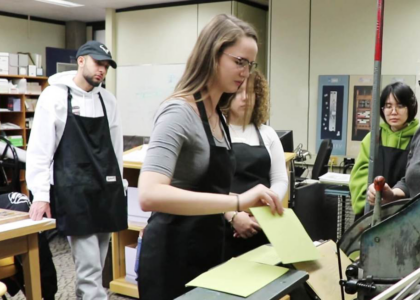
While we live in an era where digital books and printing is everywhere, the printed word remains a powerful touchstone to everything from emotions to a sense of history, says James Roussain, the interim William D. Sharpe Chief Librarian at the John M. Kelly Library. Think of an inscription in a book from a deceased loved one, the magazine with a cover noting a significant moment in history, filed away for posterity, or the joy of perusing shelves in a bookstore. Books and other types of printed materials, like posters or ephemera, he adds, are even used to decorate, a powerful indicator of what a person values and sees as esthetically pleasing.
The re-launch represents the fruition of years of planning for, and dreaming about, a space where experiential learning can help students understand the power and importance of the printed word. The original studio opened in 2002, but was closed in recent years, awaiting repairs and renovations. Over those years, the studio published three chapbooks, small pamphlet–stitched booklets.
“The pieces have come together for a better integrated program, with a more welcoming space,” says Roussain. “We have created a comfortable environment for students, with better ventilation and more space for printing demonstrations or student engagement. Recent renovations have doubled the footprint of the studio and bumped up the number of seats to 24.”
Working in the studio, students will have the opportunity to design layouts and set type, choose inks and papers, and print using the library’s collection of 19th-century printing presses. Future courses will also teach students how to bind books using traditional and modern methods. “We want students to explore the incredible variety of crafts that together make up the book arts,” says Roussain.
The Print Studio builds on the Kelly Library’s collections of rare book and archival materials. Not only can students see and handle examples of printing from its earliest days, they can also learn and sample methods of production, quickly discovering the complexities of the art and its impact on our lives.
The studio, located on the second floor of Kelly in Rm. 233, houses a variety of 19th- and 20th-century printing presses. Surrounding the presses are type cases– wooden drawers full of metal type, painstakingly set in the presses by hand, while shelves ringing the room are loaded with ink and the various other items needed to bring the presses to life.
Roussain says there are many people to thank for the improved studio space, from the Friends of the Kelly Library, who donated $18,000 towards the renovations, through to the energy and vision of St. Michael’s Principal Irene Morra, who has worked to create new links between the studio and course offerings available in the Book and Media Studies program.
The studio re-launch takes place on Thursday, March 21 at 6 p.m., beginning with a lecture in Room 105 of Kelly Library offered by Victoria University Principal Angela Esterhammer and titled “Stranger than Fiction: Scottish Emigrants and Print Culture in the 1820s.” A reception will follow, and then a demonstration in the Print Studio, led by Kit MacNeil, who teaches a course in St Michael’s Book & Media Studies program and serves as Master Printer at the University of Toronto’s Massey College. All are welcome to attend.
A brief moment in Jessica Johnson’s The Future of Journalism class offers a powerful example of how different that future looks for young adults.
Johnson, a noted Canadian writer and editor, includes a photo of Adrienne Arsenault and Ian Hanomansing, anchors of The National, CBC’s flagship television newscast, in a PowerPoint presentation she shares with her students. When she asks her class of 30 or so if anyone can identify them, no one volunteers a response.

But you would be wrong to think that Johnson’s students are not engaged with journalism or that they are unaware of critical issues in the world, as well as the challenges and opportunities in modern media. The incident underlines Johnson’s desire to demonstrate the rapidly changing face of media today.
Much of the structure and content of The Future of Journalism is based on her experience while teaching #MeToo and the Media with the late Anne Kingston in 2019, a class that looked at the media’s – and particularly social media’s – role in the social movement that stemmed from reports of predatory sexual behaviour on the part of powerful, high-profile men.

A few moments later, St. Mike’s student Lucas Sousa offers a succinct explanation of Bill C-18, or the Online News Act, legislation that was designed to see news outlets paid for work shared on social media platforms but which has resulted in news being blocked on Facebook and Instagram. He follows up by identifying an image of Catherine Tait, president and CEO of the Canadian Broadcasting Corporation, who recently oversaw significant job cuts at the federal broadcaster.
In the ensuing discussion, Sousa and his classmates demonstrate that while today’s young adults may not sit down promptly at 10 p.m. each night to watch a newscast their parents grew up on, they are knowledgeable consumers eager to learn more about fruitful engagement with authentic media. And that, says Johnson, was one of her goals in creating the course.
“What Anne and I found was that what we needed to teach how the media works, the role of social media, the industry’s business models,” she says. “The Future of Journalism is the story of media: what is journalism, its issues and practices, questions surrounding EDI (equity, diversity and inclusion) and who has a voice. We are talking about what the landscape is like, and students are sharing their thoughts on what journalism is and how they want to do it.”
The result is the Thursday morning survey class, which falls under Book & Media Studies, one of St. Michael’s four sponsored programs. According to the syllabus, by the end of the course, “student will acquire an overview of the current state of journalism, along with exposure to journalism practices and current issues.” Participants, it adds, will have gained confidence in public speaking, as well as in meeting deadlines and producing work that reflects their own original ideas.
Since the class includes both those interested in journalism from an academic perspective as well as those who hope to build a career as journalists, lectures and discussions are geared to both, looking at the theory of journalism – for example, the media and democracy – as well as offering practical discussions on how to pitch a story to editors how to use the fundamentals of journalism to build “engaging, successful stories.”
Young people want to change the world, Johnson notes, and journalism is a place where they can still do that, so she spent time while building the course pondering what they need to hear.
One challenge is learning the difference between journalism and advocacy, allowing the power of facts speaking for themselves, she says, adding that there are occasional exceptions to that dividing line, citing as an example The Narwahl, the much-lauded non-profit Canadian publication that does investigative work into environmental issues.
Because the media landscape is changing so rapidly, Johnson re-thought the content and shape of the course more than once. When she began to think about what she wanted to teach she was focused on issues such as the impact of artificial intelligence but now the world faces two major wars, the United States is in an election year and it could end up an election year for Canada, too.
“Today we see suspicion and mistrust of media. While confidence is still relatively high in Canada, it is dropping,” she observes. Part of the problem, she says, is the decline in local media, as cost-cutting continues to eliminate local outlets. Instead of smalltown newspapers and radio stations covering important local stories, for example, that news is being reported on by people unfamiliar with local issues, or not at all aware.
“If you have stories that are being told by strangers rather than reporters you see in the street, with the two-way discourse that comes from being out and about all the time, you lose key insights and context.”
There are also emerging conversations on what is truth and how differentiating factors of that truth can be identified, information critical for astute media consumer, she says. It’s a topic of increasing importance as it comes at a time when fewer and fewer publications rely on fact checkers, who confirm the content of a story, noting that The Walrus, the Canadian magazine where she served as Editor in Chief from 2017 to earlier this year is, along with The New Yorker, one of the few periodicals still relying on the role.
For her students pondering a career in journalism, Johnson will address questions surrounding the changing business models of the industry and the impact that has on quality, as well as the ways in which young people entering the field need to be entrepreneurial to find their own space.
Whether students are in the course for the love of reading news or the hopes of reporting it, Johnson sees a key goal being to support her students, and especially those who show promise.
“I love teaching and I have a lot of respect for full-time profs. It takes a great deal of time to think about what students need to know now,” she says.
“I want to help students have a vision of themselves,” she says, citing a high school teacher and a couple of university professors who spoke positively to her about her writing. Voicing that feedback may make all the difference, she says. “That may be the only person in your life to who says, “You’re a good writer. You’re allowed to proceed.”
For student Lucas Sousa, enrolling in The Future of Journalism is helping him decide what he wants to do when he graduates.
“I’m in this class because I want to see the future of journalism,” he says, adding that writing for The Varsity, the University of Toronto’s student newspaper, has given him insights into some of the topics—and challenges—discussed in class. “This course is helping me to understand things in a better way and it’s allowing me to fall back in love with journalism.”
Dr. Felan Parker is a Professor in the Book & Media Studies program specializing in digital media, video games, and media industries. His current research explores the production, distribution, and reception of independent or “indie” games, and the role of fan conventions like San Diego Comic-Con in contemporary popular media cultures.
University of Toronto Quarterly recently published Prof. Parker’s review of The Far Shore: Indie Games, Superbrothers, and the Making of Jett, as part of their big “Letters in Canada 2021” omnibus issue.
San Diego Comic-Con (SDCC) is not just any comic con, it’s the Comic-Con – with a copyrighted hyphen to prove it. Although fan conventions celebrating popular media like comics, games, film, and television can be found in all corners of the world, SDCC occupies a privileged place. Over the course of its 50+ year history, SDCC has become a key venue for both grassroots fan community and large-scale media industry promotion, driven by much-vaunted claims of exclusivity: exclusive collectibles, exclusive previews, exclusive celebrity appearances, and exclusive access (approximately 130,000 people attend each year, many more wish they could). The convention takes place over five days in July and offers something for practically everyone: panels and workshops large and small, cosplay (dressing up as pop culture characters), signings, a massive exhibition hall full of retail booths, screenings, gaming, interactive promotional activations, portfolio reviews for aspiring creators, and a lot of walking around and waiting in line.
SDCC has been the subject of extensive academic research; it offers a unique site to investigate the relationship between audiences and media industries, and the intermediaries (including SDCC itself) that shape those relationships. This is a rich body of work, but the daunting scale and scope of SDCC means that every attendee has a different experience, and it is impossible for one researcher to apprehend the event in its totality. My colleague Benjamin Woo (Carleton University) and I decided to try something different: what if we studied SDCC with a large, coordinated team of researchers?
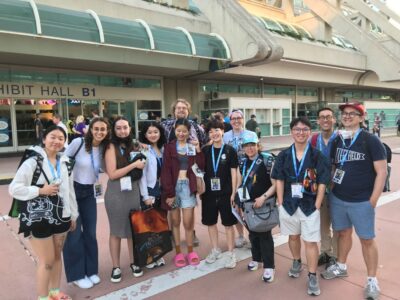
Inspired by previous methodological experiments in “swarm ethnography” and “collaborative event ethnography,” we assembled an all-star team of fandom and media industry scholars, graduate students, and undergrad students from the Book & Media Studies program. The goal of this project, dubbed Swarming San Diego Comic-Con, was to better understand the role of SDCC in contemporary popular culture by conducting up-close and personal ethnographic research from a wide variety of different perspectives, simultaneously. We successfully applied for a SSHRC Insight Grant to support a research trip to SDCC, originally scheduled for 2021 but ultimately delayed until 2023 by the ongoing pandemic.
After a crash course in ethnographic research methods and a test run at the much smaller, less mainstream Toronto Comic Arts Festival, we set out for San Diego with our six intrepid undergrad researchers in tow. Even after reading extensively about SDCC and hearing from more seasoned con-going members of the team, nothing can prepare you for its overwhelming magnitude and dizzying range of activities demanding your attention. For Shurui Wu, the research trip allowed her to combine her life-long fandom with her academic interests – disembarking the trolley in front of the San Diego Convention Centre for the first time and seeing the massive crowds of fellow fans was a “dream come true.”
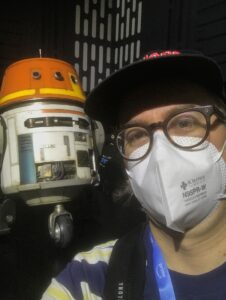
Over the course of SDCC, the “undergrad squad” (as they dubbed themselves) had many unique and exciting experiences. Along with several other members of the team, Esmé Sanders was delighted to have the opportunity to see Japanese horror comics master Junji Ito in the flesh. “Lining up for 2+ hours and getting front-row seats was rewarding and made me feel like I got the full Comic-Con experience. I enjoyed watching Junji Ito draw live. It’s a privilege to see the behind-the-scenes process of some of your favourite art!” Jae Kim and Brian Tin shared their own similar experience of getting up before the crack of dawn and joining a huge line to score an exclusive Star Wars Tamagotchi toy featuring Grogu, AKA Baby Yoda.
Indeed, lining up is a big part of attending SDCC, and the lines not only build anticipation but also are important space for community-building. Jae Kim found the environment more friendly than he imagined, highlighting the important social aspect of the convention that is easily overshadowed by the flashy Hollywood promotion and consumerism. “Starting up conversations with people in lines, by the entrance, and even in washrooms came to me like second nature. In a way, it reminded me that we were all at SDCC because we were all fans, which was a nice sentiment to have amidst the chaos.” Likewise, Debi Jin was thrilled to happen up on an autograph signing session with Makoto Yukimura, creator of the popular manga and anime Vinland Saga. Although the signing was only for people who registered in advance, she joined a small group of fans looking on. “As I looked at the faces of those in our little group, however, it seemed to me that we were all just happy to be in Makoto Yukimura’s presence. After he signed the last lucky fan’s merchandise, we all clapped and slowly went our separate ways.” The experience of seeing beloved creators in the flesh is enhanced by the communal atmosphere of the con.
Students also observed that the demographics of SDCC were not what they expected based on their experiences in fan cultures, which are often unwelcoming spaces for women, people of colour, queer folks, and other groups marginalized on the basis of identity. “Before going, I expected a hyper-masculine space filled with sweaty (and sometimes smelly) fans (myself included),” Brian recalls. “But the diversity of con-goers, in terms of age, gender, race, really pleasantly surprised me (and the venue smelled reasonably fine).” Nevertheless, there remain many issues around inclusivity and access. Esmé noted that while there were many fans with disabilities in attendance, accessibility accommodations were lacking: “it still seemed like a hectic place to navigate with an assistive device. It underscored the need for even more comprehensive accessibility measures at events like these.”
Although SDCC 2023 was billed as a return to form after several years of online and smaller-scale cons, the announcement of strike actions by the Writers Guild of America and later the Screen Actors Guild-American Federation of Television and Radio Artists against the Alliance of Motion Picture and Television Producers made labour issues in Hollywood and beyond a unexpectedly central area of interest for the project. Would SDCC be diminished by the lack of big Hollywood stars promoting their work? Or would it be a return to an imagined grassroots past before Hollywood took over? Even though she would have liked to see celebrities, Shurui wasn’t too disappointed, because there was still plenty of exciting content from other sectors of the global entertainment industries. “I was surprised by how many Japanese companies where there, and the scale of their booth and activations. This made me finally understand how influential Japanese [media] industry is.”
The focus on labour issues also raised questions about how fans are compelled to participate in marketing and promotion. “One moment I found particularly striking was when fans were lining up to advertise (post) on social media pictures of the Hello Kitty x MetaZoo booth for a chance to win a gift basket,” Esmé says, echoing fan studies discourses on fandom as a form of unpaid labour. “It felt like a lot of physical labour and free advertisement.”
The research trip concluded with a debriefing and brainstorming session with the whole team at UC San Diego, where students compared notes, shared insights, posited initial observations, and raised unanswered questions that will help guide our research as we move into the data analysis and knowledge mobilization phases of the project. These invaluable contributions from Book & Media Studies students will help shape our understanding of San Diego Comic-Con and its place at the intersection of popular media industries and fan cultures.
Read other InsightOut posts
Aïsha Philippe laughs as she tells the story of her pre-school self, so desperate to read that her mother would find her, upside-down book in hand, frustrated that she couldn’t yet make the magic of the text on the page in front of her come alive.
Today, she says, “Fiction, non-fiction…I’ll read anything!”
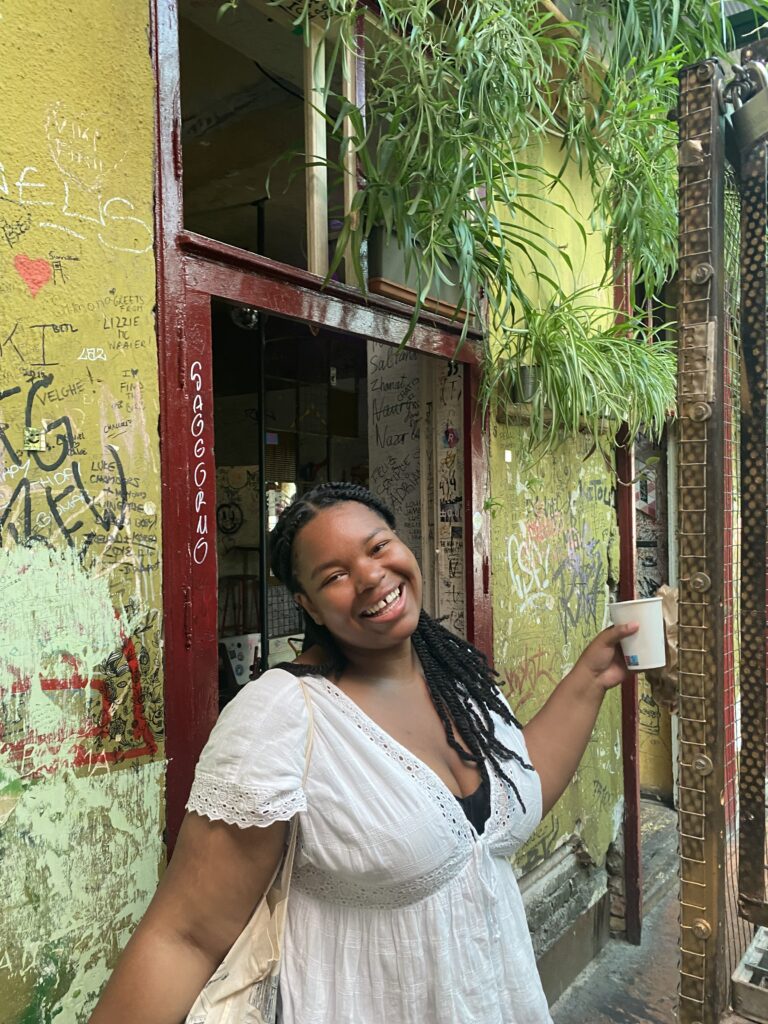
That lifelong love of reading drew Philippe into St. Mike’s Book & Media Studies (BMS) program, with the other field of her double major Political Science, each supporting her great passion for education policy. As she reflects on the joy and relaxation that reading has brought her, not to mention the education and empowerment, she is firm in her desire to ensure all children have the same access to books and learning to lead fulfilled, fruitful lives.
And while a new graduate, she already has a great deal of work experience in the field. In the past year, for example, she served as a research assistant to a University of Toronto economics professor, supporting a podcast on economic inequality. An opportunity particularly dear to her heart was a placement as an intern in 2022 at the National Book Foundation, Presenter of the National Books Awards, helping with educational and public programming, communications and social media efforts, and non-profit operations and administration. One of her tasks while with the foundation was to select books that would be sent to public housing.
Her list of social and community experiences is equally impressive. For example, Philippe, who is trilingual and completed her four-year degree in three years –each year on the Dean’s List– was the co-host of Endnote, the Hart House Literary and Library Committee podcast. She was the Managing Editor of the BMS journal, Foolscap, and was the 4th year representative on the Book & Media Studies Student Association.
COVID was already entrenched when Philippe began university at St. Mike’s in 2020, so she began her degree from her home in Washington, D.C., arriving in Toronto in the fall of her second year, in September 2021.
Soon, the St. Mike’s campus became home for her, a place to meet other students of diverse views and backgrounds, people with “brilliant ideas.”
“I cannot over-emphasize the community feeling at St. Mike’s. Students are given the spaces to exchange and collaborate,” vital skills for their lives ahead, she says, offering thanks to staff for supporting a range of student initiatives.
Today, Philippe is engaged in preparatory work before starting a Master’s degree in Education Policy and Analysis at Harvard’s Graduate School of Education. Her goal is to work at a literary non-profit, with the door open to doctoral work down the road.
Looking back on her time at St. Mike’s, one of the opportunities she valued the most was helping to plan and present events during February’s Black History Month. Along with a panel discussion, a movie night and a dance class, the U of T Black Students’ Association and St. Mike’s hosted an open mic night, featuring spoken word poet Eddie Lartey, winner of the 2022 Canadian Individual Poetry Slam.
It was an event that really resonated with students, she notes, recalling that the evening saw a lot of engagement, with people taking chances by sharing their ideas, their work. And that, she says, reflects one of the key take-aways from her time at St. Mike’s.
“Put yourself out there,” Philippe says. “It’s easy to count yourself out, but there should be no regrets —even if you fail—because you’re still learning. Make the most of your time!”
TORONTO – Who best to teach a course on AI literacy than AI itself?
Fall 2023 brings class at the University of St. Michael’s College that will be taught almost entirely with artificial intelligence tools. “AI as a Classroom” is an advanced fourth-year seminar that will be offered as part of the Book and Media Studies Program (BMS) at St. Michael’s College, in the University of Toronto.
“AI as a Classroom” will address a variety of issues concerning AI and its influence on society, including the ethics of AI and the impact AI has on cultural and media landscapes. It will also engage with provocative questions about the role of the professor in the creation and curation of the learning experience and in the potential of AI to enhance learning and promote proactive thought. Using the most advanced technologies in the field, including generative AI and LLMs, the course will feature a customized version of ChatGPT that has been expressly trained on course research questions. Throughout the course, students will develop skills in the use of AI in order to develop cutting-edge critical analyses of AI from a variety of ethical, practical, and philosophical perspectives.
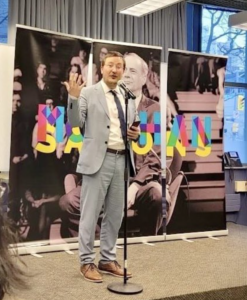
The course is the brainchild of Associate Professor Paolo Granata, (left,) who has a history of engaging in experimental pedagogy. During the pandemic, Granata used virtual reality (VR) technologies to foster experiential learning. He sees this course as a way of expanding these explorations of new media and the learning space.
“This is an exciting opportunity for students to explore the cutting edge of AI and its potential for education,” says Professor Granata. “By experimenting with AI tools in the classroom, we hope to provide our students with a unique and enriching learning experience that will prepare them for the challenges of the 21st century, where AI literacy is key.”
Inspired by the legacy of Canadian philosopher Marshall McLuhan, the Book and Media Studies Program at St. Michael’s College has been at the forefront of experimentation in media education and digital literacy. Based on Marshall McLuhan’s adage “The Medium is the Message”, this course will provide an innovative context through which to investigate the potential for AI to enhance human agency in previously unimaginable ways.
For information about the course, contact usmc.communications@utoronto.ca.
St. Michael’s Profs Use Creativity to Remotely Engage Students
As a scholar of video games in popular culture, St. Michael’s Assistant Professor Dr. Felan Parker is deeply familiar with entertainment platforms used to livestream video games for an audience, a genre of media that has only grown more popular among Parker’s students since the pandemic forced their lives online.
Parker puts his expertise to use by using the streaming platform Twitch to teach, offering critical and academic commentary on his own playthroughs during his courses and virtual events. Doing so enables him to provide direct insight into issues of form, themes, tropes, and even the economics of production in the context of the games themselves.
“I think being a media scholar is a double-edged sword in this situation,” says Parker. “On the one hand, I have practical knowledge of digital media and conceptual understanding of how to use them effectively, but on the other hand I am acutely aware of the challenges and potential problems with digital platforms,” he says. Making sure students understand how platforms leverage user data for targeted advertising, for example, has been important to Parker during the transition to remote teaching.
Each week for classes such as his First-Year Foundations course How to Study Video Games, Parker uses Twitch to play a different game live on stream with running commentary about how it relates to the topic, and students will chime in using the text chat function.
“Rather than being passive observers, I’m taking advantage of the interactivity of the platform to encourage students to be ‘backseat players,’” Parker says. The active involvement of his students during in-class streams ranges from their own observations about the game and connections to other class materials to crowdsourced decisions that Parker uses to drive ahead the game’s action.
The Twitch engagements provide a foundation for further discussion, and Parker uses the stream in part to model “a critical and analytical mode” for students to practise when they interact with games. Twitch also factors into the course content because it’s become an essential promotional tool for game developers as well as a major presence in gaming’s cultural ecosystem. In his research, Parker explores the way the streaming platform has become essential for independent game developers to market their wares, and in class he uses it to showcase games his students may not have seen or been able to access before.
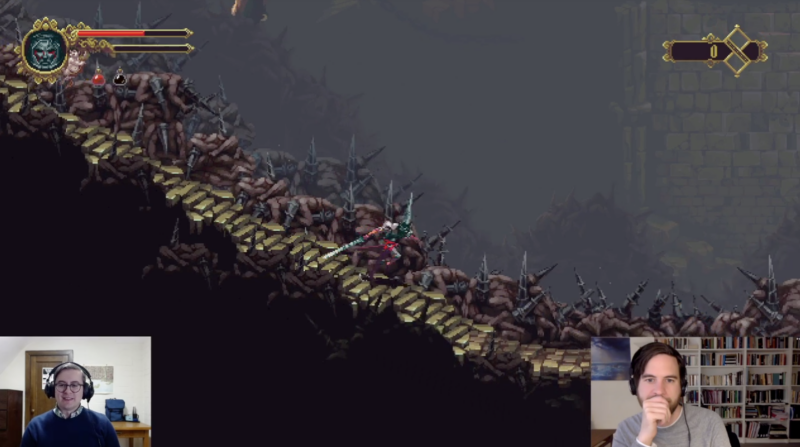
One example is Blasphemous, a game Parker played on Twitch to kick off Streaming SMC, a new series in which he invites fellow St. Michael’s professors to join him to discuss games relevant to their expertise. As Parker’s St. Michael’s colleague Dr. Stephen Tardif offered commentary linking the game’s pseudo-Catholic aesthetics and narrative to real-world sources, Comper Professor of Medieval Studies Dr. Alison More entered the chat to provide historical insight into subjects ranging from 13th-century understandings of purgatory to medieval penitential movements.
The way games and other popular media help to shape and inform modern culture is one of the interests that drives Parker’s research. This year, he joined scholars from several other universities to collaborate on a SSHRC grant–funded project, Swarming SDCC, which looks at the complicated relationship between media industry producers and fans. The two groups have very different relationships to both entertainment franchises and the ComicCon events that showcase them, as Parker and his collaborators argued in an article for The Conversation. Eventually, Parker says his hope is to bring his students into the project as researchers “to participate in the actual on-site ethnography.
“I always strive to give students the tools to bring a critical perspective to bear on the digital media and technology that structures their everyday lives,” says Parker. “This feels particularly pressing in this moment, since for better or for worse we are more immersed in digital media than ever.”
_____________________________
Consult Fall 2020 for current updates on St. Michael’s plans for the fall semester.
In the aftermath of the 2013 acquittal of George Zimmerman, the man responsible for the death of Black teenager Trayvon Martin, a hashtag began to circulate on Twitter: #BlackLivesMatter. In the years that followed, the hashtag has transformed from a rallying cry in response to police violence against Black people to a powerful movement for racial justice and equality around the world.
Starting in the Winter term, a journalist, scholar, and activist who has been deeply involved in the conversation about the movement in Canada will teach a high-level seminar on #BlackLivesMatter in the Book and Media Studies program at St. Michael’s.
“To answer the question of the relationship between the movement and the media, it is necessary to answer a second question: do Black lives matter in the media?” #BlackLives and the Media course instructor Emilie Nicolas says. “That second question is the question that goes way before the creation of the [BLM] movement, which is very much the latest iteration of a human rights movement that goes back generations.”
Providing this historical context for #BlackLivesMatter is an important goal for the course, which will also provide a critical perspective on the dynamics of power and the complicated interrelationships between the movement and the media environment in which it emerged. Because the media environment varies from country to country, Nicolas will also offer a comparative international perspective to help students grasp the nationally specific characteristics of the movement and its reception around the world. Though the hashtag first appeared in response to violence in the United States, it’s important to remember that #BlackLivesMatter “is not just an American movement,” she says.
As a columnist for Québécois newspaper Le Devoir and a regular contributor to national outlets such as CBC’s Power & Politics and CTV’s PowerPlay, Nicolas has spent years observing and participating in conversations about how the media covers stories about Black people—and how it can fix its coverage. She also “contributed to social movements and organized on behalf of victims of police brutality in Montreal,” and several years ago helped head up a group that lobbied against Canadian media using blackface. This larger background in both journalism and organizing will fuel a course that provides an inside look at the dynamics of both media institutions and the movement for racial justice that sees media as a “battleground.”
With guest speakers including both reporters and organizers, the course will also be responsive to breaking news, including the aftermath of the upcoming American election. “When we understand the relationship between anti-Black racism and the media better, we can understand the news better,” Nicolas says.
#BlackLives and the Media continues a series of topical Book and Media Studies seminars that began in 2018 with Trump and the Media, a class taught by journalist and former New York Times editor Sam Tanenhaus. Last year, the series continued with #MeToo and the Media, which was jointly taught by Jessica Johnson of the Walrus and the late Anne Kingston, a senior writer and columnist for Maclean’s.
“In its efforts to educate students in media literacy, the Book & Media Studies Program must engage the salient issues of the day, particularly those of social justice, media manipulation, and systemic racism in North American society,” Interim Principal and Vice-President Mark McGowan says. “It is imperative that our students explore the engagement of #BlackLivesMatter and the media and I am delighted that St. Michael’s College can provide a forum for this important conversation.”
SMC300H1S #BlackLives and the Media will be taught on Fridays from 12 to 2 p.m. during the Winter 2021 term.
Isabella Mckay is a senior student majoring in Book and Media Studies at the University of Toronto. Following her passions in marketing, communications, technology, and media, she has become the Vice President of TechXplore, the Director of Marketing of Data Science Toronto, and the Assistant Project Coordinator at the University of Toronto Faculty of Arts and Science Dean’s Office. Mckay looks forward to applying her passions and work to innovate the future.
Love and Happiness as True Measures of Life
During the coronavirus pandemic, I have discovered that the principles of humanity, which are love, togetherness and health, exist as the ultimate purpose and meaning of life.
On January 27, 2020, the National Microbiology Lab in Winnipeg confirmed the first case of coronavirus in Toronto. Remembering the words of my mother to not fear and panic but be prepared and cautious in case of emergencies, I bought one of a few alcohol rub left at a pharmacy in Toronto. At my condo, I found one pack of 20 N95 masks for around 85 dollars with express shipping on Amazon. Although I could search for cheaper masks, future prices would likely increase, and then I might search longer to find no masks and sacrifice my health. I would work to recoup the price within hours; however, I would spend more time and energy to regain what was most important, my health. I purchased the N95 masks within three minutes.
When coronavirus cases rapidly increased after February 24, I had the proper procedures and supplies to calmly protect myself from the coronavirus while others began to panic. I still socialized with friends, studied at the libraries, and attended club events at the University of Toronto.
Then, the University of Toronto announced that, as of March 16, it would close, and move to online courses and examinations to limit coronavirus cases. I wore my N95 mask as I walked around the campus and a downtown Toronto that resembled an abandoned town devoid of energy and emotion.
Before the coronavirus pandemic, I huddled in a tight and quick one-way line of students to attend my classes on time. Now, I freely and slowly roamed past three students on my way to the library. I used to walk around for five minutes to find an empty library seat and to hear pencils and pens scratching on paper during midterm and final exam season; now, however, I found an empty seat and heard the hum of the air conditioner as soon as I walked into the library. I used to sit next to students who flipped through pages of homework, wrote mathematical equations and assignments, and coded programs. As I sat in one of the hundreds of empty seats, I remained two metres or more from other students because of my own preferences or because of tape placed between every two desks and in front of desks.
With the cancellation of on-campus classes and exams, I returned to my family home in Vancouver on March 21. Although the Canadian government did not require citizens to self-isolate on a domestic flight, I feared that someone might have coronavirus on the plane. I wanted to ensure that I had no symptoms and that I would not transmit the virus to family. If I transmitted the virus to my family, I would fail to mend my shredded heart.
Although I talked to my family and friends through my phone during isolation, I became an outsider who might have a disease that everyone feared. I yearned to be near my loved ones, especially my family who sacrificed their time and health to care for me. I did not want, and was not motivated by, my empty university scores and jobs, which for years I had desired most; instead, what I wanted and was motivated by was familial love and unity.
Once I left self-isolation, my family revealed that they struggled to obtain essential groceries and supplies. Before the coronavirus, my family and I might spend half an hour choosing organic and natural vegetables among full shelves. Now I wore ski goggles, plastic gloves and a N95 mask as I social distanced to purchase any supplies at a local grocery market.
Similar to food and supplies, before the coronavirus stole the simplest moments, I took daily and normal activities for granted in order to pursue my career and high marks. I carelessly walked, compared to now seeing someone and moving to the other side of the road. I carelessly talked to others, compared to now yelling over two metres to discuss the coronavirus lockdown. I carelessly socialized with friends compared to messaging them. I carelessly went anywhere to perform multiple activities compared to restricting myself to my home and grocery trips. Appreciating people and the simplest things are blessings of happiness. I am not measured by what I have, but who I am and how grateful I am to have what I have.
Once the lockdown ends, I will refuse to let fear control my life and I will experience the meaning of life: to be around loved ones and increase happiness activities. When will I get another chance, and who foresees the future?
The coronavirus pandemic has taught me how health is the most important quality and how everything else is minor, how people, and the smallest and simplest things, deserve appreciation, and how love and happiness are true life measurements. These essential human qualities are the purpose and goals of an amazing life and these human foundations will support the fight to defeat the coronavirus.
Read other InsightOut posts.

